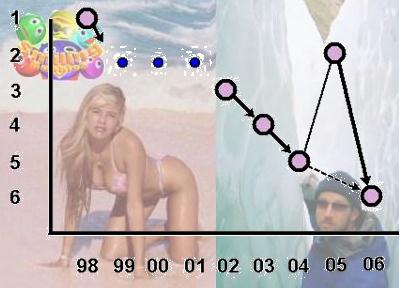Update (January 2008): 2007 turned out to be the coldest year of this century according to RSS MSU.According to the most recent data from the World Meteorological Organization (WMO), the year 2006 is set to be
- colder than 2005
- colder than 2004
- colder than 2003
- colder than 2002
- ... and, most obviously, ...
- colder than 1998,
despite the new El Nino that has been warming the Earth again for a couple of months at the end of 2006 and that will probably continue in 2007. Yes, right now it seems that 2006 will become the coldest year among the most recent five years, and it will belong to the colder half of the years in the last decade.
The number of hurricanes in 2006 was below the long-term average. The total number of Atlantic tropical storms was the second lowest number during the last 12 years, after 1997.
Using the WMO terminology, 2006 is set to become the "sixth warmest year" after 1998, 2005, 2002, 2003, and 2004: see WMO's top five. Nevertheless, when a naive and innocent girl would read most of the newspapers, she would most likely start to think that we live in an era of a spectacular global warming. In reality, we live in an era of a spectacularly inexpensive propaganda produced by unusually blinded ... pundits.
And that's the memo.
P.S.: See Investors.com for a similar analysis of the news and a more complete graph including the years 1999-2001. Don't you think that the graphs resemble currency exchange rates and follow similar fuzzy logic? See also the NOAA report.
Also, the new HadCru data released in January 2007 confirm the ordering of the years captured in the following graphs: the temperature anomalies from 1998 to 2006 were 0.526, 0.302, 0.277, 0.406, 0.455, 0.465, 0.444, 0.475, 0.422.
Figure 1: Global cooling. This graph, depicting 6 warmest years since 1998 according to their rank, shows how Al Gore and other people with comparable scientific standards would be presenting the recent temperature records if cooling or a new ice age became more convenient for their goals than warming.
Note that various tricks that are popular with some politicians and journalists-activists are used although not as intensely as in the media. The beginning of the graph is appropriately chosen. Some years that would lead to undesirable conclusions are removed. The decreasing links are emphasized and scientifically interpreted while the increasing links are suppressed and painted as scientifically irrelevant episodes.
Some particular years, in this case 2005, are drawn as exceptions from the underlying trend if it can help the case. In fact, I forgot:
They would also add pictures that would make it clear that the past climate is what it should be while the future is a disaster: yes, the guy is stuck in between two glaciers and all of us will be. ;-)
They would also extrapolate the graphs in some catastrophic way up to 2050 and beyond and shoot a cynical movie about all these threats. A campaign showing that the CEOs of the companies producing heating devices - together with the nasty owners of the ski resorts - are vampires who are ready to sacrifice the planet to increase their profits would follow. Steve Jobs is a vampire, too: he is selling millions of white iPods that increase the reflectivity of the Earth, via the mirror effect, and bring us closer to the new ice age.
Media would inform you that they want to hide that a new ice age is imminent. We would be constantly reading about 25,000 Britons who froze to death during the 2005-2006 winter. Scary hurricanes would be described as a consequence of global cooling and heat waves would either become unimportant weather events or consequences of the global cooling.
The world would be different in details but the general picture would be isomorphic.
The Improving State of the World
Indur Goklany, a former EPA official, has collected 450 pages of data showing that the world is cleaner, happier, and healthier than ever before. The new book is recommended by various famous people such as Nobel prize winners and Chicago economists but not only them.
Goklany shows amazing numbers how the economic growth and technological progress has improved nutrition the in the third world, how it has made the environment cleaner - the countries that have abandoned communism are an important example. The food prices in real terms dropped by 75 percent in the last 50 years. The life expectancy has grown tremendously and the infant mortality has decreased four-fold. Also, it is cheaper to adapt to different temperature than to try to stop its change by introducing heavy-handed interventionism.
One of the things that the book disproves is the hypothesis that the economic growth leads to an increasing damage of the environment.
Some additional well-known climate articles on this blog
- Cosmic-climate and solar-cloud connections
- Lord Christopher Monckton and global warming
- Warming - rising temperatures - drove and preceded CO2 concentrations, not the other way around
- The Global Warming Swindle
- Temperature sensitivity on carbon dioxide
- 2006: a sad year for alarmists
- Climate change in the rest of the Solar System
- Garrett Lisi - a theory of everything (about a crackpot)